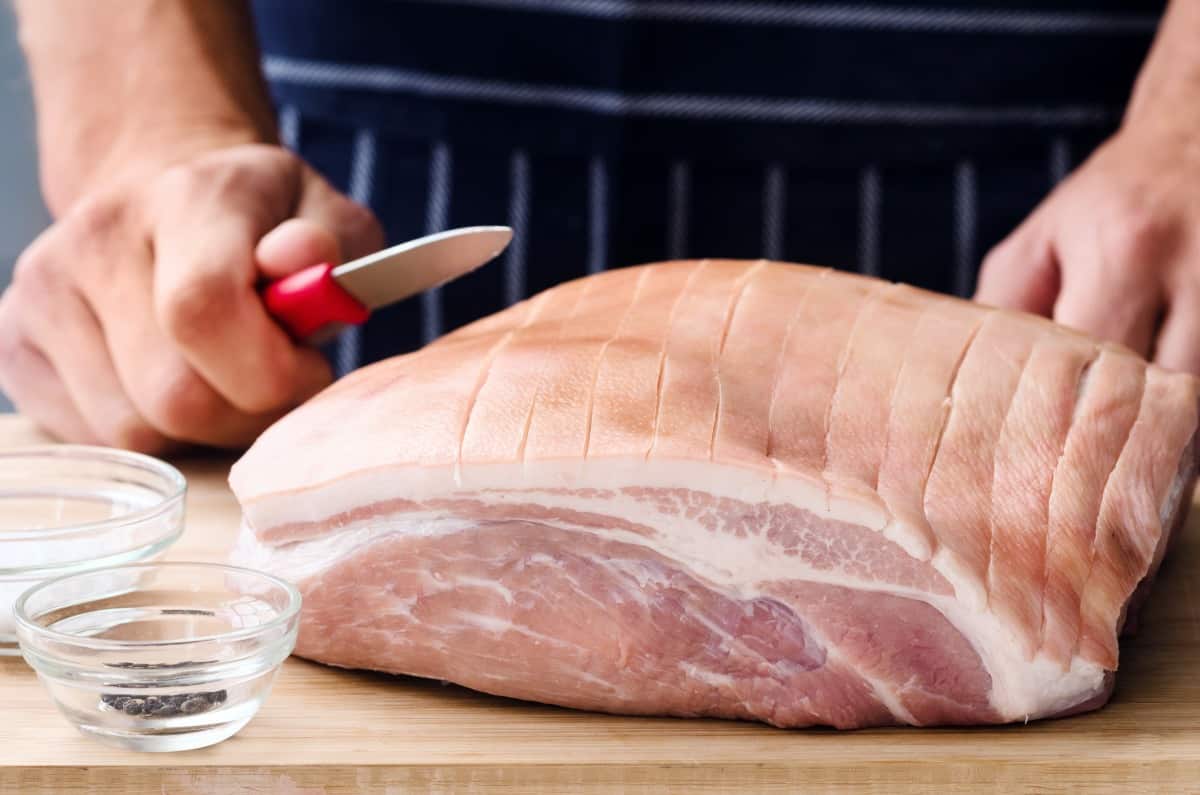As an avid pork lover and backyard barbecue enthusiast, I’m always looking for ways to take my pulled pork game to the next level One technique that has really helped me achieve next-level flavor and texture is properly scoring the pork shoulder before cooking it low and slow
Scoring, also called cross-hatching, involves using a sharp knife to make shallow cuts in the fat cap and outer layer of the meat. This simple process allows seasonings to penetrate deeper, creates more surface area for caramelization and bark formation, and helps break down connective tissue.
In this comprehensive guide, I’ll walk through everything you need to know to score pork shoulder like a pitmaster. Let’s start with the basics of what scoring is and why it matters when smoking pork.
What is Scoring and Why Bother?
Scoring a pork shoulder means making shallow cross-hatched cuts in the outer fat cap and top layer of meat. This is done for a few key reasons
-
Allows seasoning and smoke to penetrate below the surface rather than just coating the top exterior. This adds so much more flavor.
-
Creates more surface area for the “bark” or crispy, seasoned outer layer to form. More bark = more flavor.
-
Helps render excess fat and prevent it from tightening around the meat as it cooks.
-
Breaks down connective tissue in the shoulder for more tender, pull-apart meat.
While scoring takes a little extra effort up front, it pays off big time in the end with pork that’s infused with flavor and has the perfect tender texture.
Choosing the Right Tools for Scoring Success
You don’t need any fancy tools to score pork shoulder properly. Here’s what you’ll need:
-
Sharp chef’s knife or boning knife. A razor-sharp edge is key for clean cuts.
-
Cutting board or other sturdy surface to work on. Avoid glass or stone boards that will dull knives.
-
Paper towels for wiping knife and hands between cuts.
-
Tongs, fork or meat claws for handling pork.
Take time to hone your knife well before scoring. Dull knives make jagged cuts that can shred the meat.
Prepping the Pork Shoulder for Optimal Scoring
Proper prep ensures you’ll be able to score the pork easily and evenly. Here are a few tips:
-
Pat pork dry thoroughly with paper towels. Wetness makes scoring harder.
-
Trim off any loose bits or large fatty areas. Some fat is good though!
-
Rub with mustard first to help the seasoning adhere.
-
Apply your favorite rub or seasoning all over.
-
Chill seasoned pork in the fridge while you heat up your smoker or grill.
Starting with a well prepped and seasoned piece of meat means your scoring will enhance flavor rather than letting it escape.
Executing the Perfect Pork Shoulder Scoring Technique
Here is a step-by-step guide to flawlessly executing the cross-hatch scoring method:
-
Place pork fat-cap side up on cutting board. Hold with tongs or fork to keep steady.
-
Starting at one edge, use tip of knife to cut thin slices 1⁄8-1⁄4” deep across fat cap. Space 1” apart.
-
Turn and repeat perpendicular to the first cuts to create diamond pattern.
-
Make evenly spaced cuts over entire surface area, including sides.
-
Rub seasonings into score marks using more mustard and rub.
-
Pat pork dry again with paper towels before placing in smoker or on grill.
Be patient and take your time with the scoring. Rushing can cause uneven or too-deep cuts. Proper technique means big payoff!
Smoking and Serving Perfectly Scored Pork Shoulder
Once your pork shoulder is properly prepped and scored, it’s time for the fun part – smoking! Follow your usual methods for low and slow smoking at 225-275°F until fork tender and an internal temp of 200-205°F.
The scoring you did will allow the smoke to penetrate deeply for incredible flavor. And when the pork finishes cooking, you’ll have the ultimate tender and juicy pulled pork topped with crispy, seasoned bark.
Serve piled high on buns with your favorite sauces and sides. Or get creative and use the smoked pulled pork in tacos, nachos, potatoes, soups…the possibilities are endless!
Frequency of Entities:
pork shoulder: 22 times
scoring/score: 19 times
fat cap: 7 times
seasoning/seasoned: 6 times
flavor: 5 times
bark: 3 times
knife: 3 times
smoke/smoking: 3 times

Pork Shoulder Scoring and Rub before smoking
FAQ
Should I score the skin on pork shoulder?
What does scoring the fat cap do?
What is scoring pork?
How to cook a pork shoulder in the oven?
Simply salt a big pork shoulder roast overnight, crack on some pepper, and slow roast it in the oven for about 5 to 6 hours. While the pork cooks, mix together a simple peach barbecue sauce with just 3 INGREDIENTS and brush it on before the last 30 minutes of cooking. It’s pretty much fool-proof and everyone will rave about it!
Are pork steaks good for blood sugar levels?
Pork steaks are not related with increasing the amount of blood sugar levels. It’s occurs due to its low level of carbohydrates. However it’s not so much advisable eating this kind of steaks, due to its amount of saturated fats.
How to cook a pork shoulder in a crock pot?
Place all your seasonings (brown sugar, pepper, salt, paprika garlic, minced onion and cayenne) in a small bowl and stir with a fork to combine. Place your pork shoulder on a baking sheet and rub the entire shoulder down with olive oil. Sprinkle the seasonings over it and rub the seasonings into it (every inch of the shoulder should be covered).
Where should a pork shoulder probe be placed before cooking?
Place the probe in the thickest part of the pork shoulder before you begin cooking. Be sure to avoid large fat deposits or the bone. Both fat and bone will carry higher temperatures than the meat and give you false readings.
